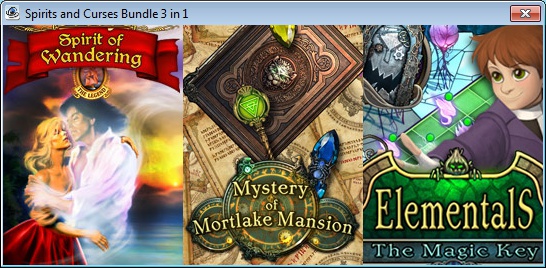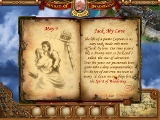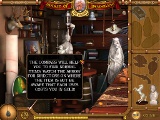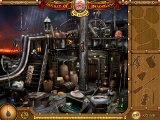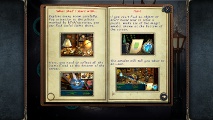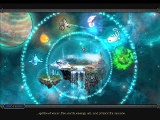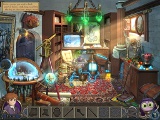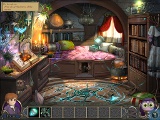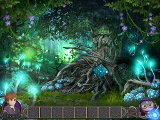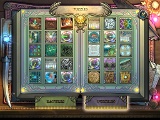





Heroic Adventures 4-in-1 Pack:
Samantha Swift 4 and the Fountains of Fate
Midnight Mysteries: Salem Witch Trials
Luxor Adventures (see Hidden Object Heroes
Bundle)
The Institute: A Becky Brogan Adventure
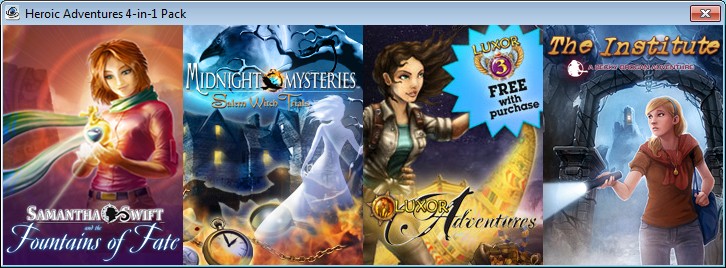
These titles are all by Mumbo Jumbo Games, and share one game with the Hidden Object Heroes Bundle, while containing next instalments of two others. The fourth game is also a second instalment, and the Samantha Swift adventures, Midnight Mysteries and Becky Brogan adventures have bundles of their own. Overlapping bundles, grumblegrumble...
Samantha Swift 4 and the Fountains of Fate had better be the last Samantha Swift adventure, because it bops off her number one enemy. In this fourth adventure, as its title clumsily indicates, the art is less mellow than in the previous three and the heroine herself appears to have had a makeover, but although the artwork is more refined, the basic gameplay is almost unchanged: her PDA and other mechanical doodads are there, the gears over an object that needs another to act on it, the moving between rooms and the fiercely radiant glow that marks each exit, the hints in descriptions, the lightning bolt in each room for extra hints, and the blue letters of extra-hidden items. This time, there are also items in green lettering that are hidden behind movable bits of scenery. The game starts with a belief-defying chase scene that lands Samantha on an island, followed by a smoothly integrated tutorial and a Help option to re-explain anything that wasn't clear. For the first time, I noticed that the Swift symbols that Samantha collects are supposed to be swallows; two of these must be found in each room. The searches are untimed, with a hint button and Samantha's scanner to show an item's silhouette; too many misclicks are punished by a brief scanner malfunction. The background music is calm with a note of understated suspense, and nature sounds mixed in. As always, Samantha hops around the globe abusing mythologies right and left, but this time she's not just doing a job for someone and/or collecting exhibits for the museum and/or trying to find her father; she is now trying to save the daughter of King Midas, who she transformed from gold to flesh in Samantha Swift and the Golden Touch, and who is beginning to age at an alarming rate, hence Samantha's search for the waters of youth.
At the end of the game, the player is awarded trophies for achievements like not using the (self-recharging) hint button, not using the scanner, and finding all objects in the order listed. The Swift symbols have a function this time: finding enough of them unlocks the "unlimited find objects mode", eight screens of "search and destroy" with a timer, the scanner and one self-recharging hint available. For these screens, the player may receive a bronze, silver or gold medal depending on how fast the screen is cleared.
See also the first two Samantha Swift games.

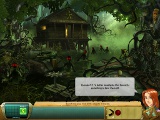
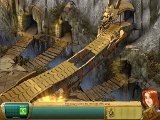
The second instalment of the Midnight Mysteries, Salem Witch Trials, has much in common with the fourth instalment of the Samantha Swift adventures: its art is in the same style as before, but more refined; its basic gameplay is the same, also with some refinements; its theme is the same as before (a somewhat fanciful investigation into the past of a known author, including attempts to wrest biographical information from his writings); it too has extra items to find for bonus hidden object searches at the end of the game - in this case four-leaved clovers, not stone tablets, and they can be very cunningly hidden - and it is, overall, an improvement on a successful formula. The first is still my favourite, as the emphasis is on spook factor, and it doesn't get spookier than Edgar Allan Poe. Still, although the author begging for justice this time, Nathaniel Hawthorne, tended to concentrate on sin and morality (particularly on how these concepts are corrupted in daily use) there is a tenuous connection between him and the supernatural through the Salem witch trials, so the intro is a nice 3D scene of witches dancing in a ring, the game starts in a ghastly graveyard and follows the life and trial of a supposed witch, as well as characters from Hawthorne's novels and his connection to the president, and Hawthorne was politically assassinated AND blighted by a witch's curse, with a bit of native American influence tossed in for good measure! For those whose suspension of disbelief stretches that easily, the game offers moody scenes set to ditto music and recorded in the new and even nicer journal, a "hints" lamp and ravens to collect for more hints, and an inventory that allows items to be combined.
See also the next two Midnight Mysteries games.
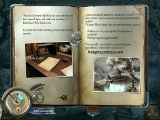
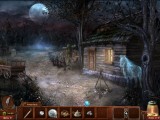
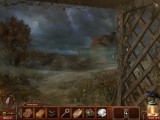
The Institute: A Becky Brogan adventure is the second
title in the series, and unlike the successful Samantha Swift and Midnight
Mysteries series, both at their fourth title when this review was written, it
seems to stop there. Maybe this series was a bit too creepy, or it wasn't
magnificently creepy enough. This game is creepy, in a way that befits Mumbo
Jumbo Games.
Becky Brogan is a schoolgirl who likes to solve mysteries, and she already
has one successful case under her belt. So why not (and apparently this is a
school assignment!) check out the whereabouts of a missing nurse? She starts at
a musty motel with a note on the door that's clearly been there for years. All
search scenes are so full of squalor that it's hard to find anything, especially
at the now deserted institution where the nurse last worked, so I just click and
hope that was the right spot, or I "find" something and don't know what item it
was that I just clicked on; luckily the searches are untimed, and the only
penalty for a false click is a non-irritating sound. The Help option explains
the scoring system, and also how to collect extra hints for the self-recharging
hint button by finding bears, which are like the ravens in the Midnight
Mysteries, except that they can appear in the strangest forms, like a traffic
sign with a bear's face. The background music is outright deranged, overlaid
with sounds of scribbling that presumably belong to Becky's "clue book" that
acts as the game's journal. Worth re-reading for its disturbing content, it
begins with noting particulars about the missing nurse, such as her harshness
towards mental patients and love of bears, then moves onto the three cases of
juvenile insanity assigned to her, and the doctor's experiments with
hallucinogenic and poisonous plants from South America. After a number of search
screens alternated with split screens and puzzles - often genuine jigsaw puzzles
- Becky's investigation culminates in a satisfying and magnificently creepy
ending. My conclusion: this series deserves to be continued.
See also the first game, Becky Brogan - The
Mystery of Meane Manor.
Spirits and Curses Bundle 3 in 1:
It's a classic theme even for those who don't read romance
novels: high-born lady travels on ship, encounters pirate captain, they fall in
love. Spirit of Wandering, which is also the name of the pirate ship,
alludes to this story by way of the lady's diary, but skips it to fast-forward
to the point where the game starts: sailing into port in preparation for
marriage, they run into the famous ghost ship, the Flying Dutchman, which
abducts the crew, leaving the lady stranded and desperate to find her
husband-to-be. Starting in the port, then moving to the sunken ship and
neighbouring islets and, ultimately, to the Flying Dutchman itself, she
liberates the spirits of each crew member by finding items that were meaningful
to them; which somehow brings them back to life and places them on dry land, I
presume. The items, while not cleverly hidden, have to be found using pictures
of their outlines, which, considering the effect of foreshortening and the fact
that the item outlines are skewed to make them fit in the search list, can make
the search quite puzzling. Luckily, there is no timer, although too many wrong
clicks makes the screen temporarily mist up or fill with snow or become
otherwise opaque in a way connected with the current scene. The search is also
not quite standard in that, for every six or so objects found in the normal way,
the scene darkens and it becomes possible to find a "spirit object" by moving a
giant lens over the screen; a ring of flames will form around it and intensify
as the lens moves closer to the right spot, the spirit object solidifying under
it until it can be clicked. A compass dispenses hints which can be bought with
gold, and it is not entirely right to say there is no timer, because every crew
member's liberation is followed by a "grab all the gold you can in three
minutes" treasure scene.
Playing the demo, I was unimpressed with the bland BGM, blah visuals and
romance novel format. That's because, in the demo, I never got as far as the
sunken ship. The music picks up after a while, and although the wrecked ship
surrounded with treasure on the ocean floor is the visual highlight, the voodoo
hut and the Flying Dutchman itself are not to be missed.
I don't have too much to say about Mystery of Mortlake
Mansion; not only did it slow down the computer horribly in the demo
version, but once a registration key had been entered, it refused to play
altogether! A bit of surfing informed me that this particular build was broken
and that maybe it would work if I set the date format to American (MM-DD-YYYY);
it did not. So all I can say is that the setting is a haunted mansion, scary
even by daylight; there is a voice-over, which depends on the gender chosen at
the start of the game; the main character appears to be a shadowy figure with a
crucifix; the opening background music is a simple, suspenseful tune; the
visuals are pretty pen-and-ink drawings, and there is match-3 involved. The game
is clearly for wide screens, as seen from the only screencap - the "book" of
instructions - that I did manage to snag.
The visuals in Elementals: the Magic Key are pretty
pen-and-ink drawings; so pretty, in fact, that I went overboard on the
screencaps. The intro alone is worth watching out, and the beautiful magical
fairytale music in the opening screen makes my default name, taken from my
Windows user account, all the funnier. This game world features six elements -
water, fire, earth, energy, air and primordial nature - and their spirits, the
elementals. They will pop up in card games and a weird checkers variant. The
player starts in the room of Albert, a swotty little student at - where else - a
magic academy, waking up on the day of his birthday after a dream of a key
breaking into pieces. A saucer-eyed floating head knocks against the window;
it's Felly, his familiar, who informs him that his older sister Lily, holder of
the key that controls the elements, has gone missing. His room is already
adorable, with lots of little details to look at and click on - check out the
carpet - but her room is of course much pinker and prettier, the ravages of a
recent struggle notwithstanding. The game is a series of little puzzles, ie.
find the dipper, find fuel, let Felly in, pack for the journey, and while a
little document-like window in the top left corner lists the items to find, a
bar along the bottom of the screen shows their silhouettes. To make things even
easier, a little sparkle in the screen hints where to look next if the player
takes too long. Anyway, Lily has been abducted by an evil ex-student who was
expelled, and the teleporter that is connected to the six elements must be fixed
so that Albert can travel to all the realms where he can find what he needs to
put the key back together and free Lily - ah, but not before he solves some card
game or other puzzle for a shady gatekeeper. These puzzles can easily be
skipped, as playing out the game successfully opens a "book" screen where the
player can re-solve all the puzzles and replay all battles, these battles being
the odd checkers variant matches, with elementals as game pieces, that Albert is
drawn into against golems, elementals, the final boss and even Lily's familiar
Sathy. His journeys take him to a wood with a talking tree, a space station and
a dragon's lair, and just as the game wouldn't dream of punishing the player for
misclicks, it ends very happily for everyone involved. An ideal game for small
children, if they can figure out the puzzles.
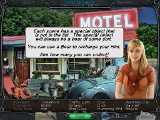
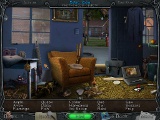
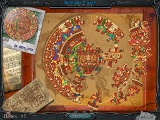
Spirit of Wandering
Mystery of Mortlake Mansion
Elementals: the Magic Key
